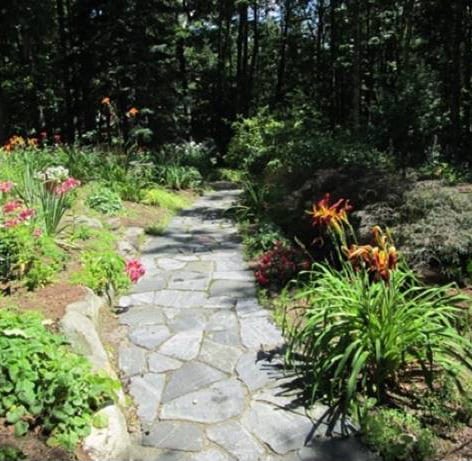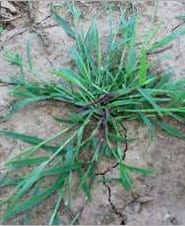Conference Session Review by Alexis Doshas
Garden designs that not only fulfill the desires of the client but also support and maintain optimal soil health translate into improved carbon sequestration and storage. M.L. Altobelli of Greenery in Motion Garden Design has years of experience with sequestering carbon in beautiful gardens and shares what she’s learned from a practical perspective. As M.L. puts it, “Manage for resiliency and adaptation to change; sell to client as electric color and healthy plants.”
Most of the soils we work in have been disturbed and the natural soil systems compromised – including the water cycle, nutrient mineralization, and soil biota ecosystems. If the soil system is not operating properly then plants cannot reach maximum health. If plants are not healthy, they will look diminished, grow slowly, produce less bloom, be less robust, and lack shine and even fragrance. The soil system must be addressed to produce healthy, aesthetically pleasing gardens and landscapes. By repairing and supporting soil health, we contribute to a healthy and properly functioning ecosystem where plants reach optimum health and beauty and nutrient cycling and storage are in balance.
Compaction
The actual work of carbon stabilization and sequestration happens in the installation and maintenance of the designed garden and landscape. Soil biota, nutrients, and water need to be able to move through pores and spaces in the soil; however, many sites suffer from soil compaction. Compaction can happen at a newly constructed home site where heavy equipment has been used, or on a turf lawn that has experienced years of repetitive mowing, or from paths and walkways that receive heavy foot traffic.
A simple approach to prevent compaction on lawns is to alternate mowing patterns and use cross cutting paths. The way to remedy already-compacted soils is to create and improve soil structure. One way to improve soil structure is to add stone dust, layer mash, and alfalfa meal. Layer mash is a poultry feed product and provides essential nutrients, vitamins and minerals. Alfalfa meal is made from fermented alfalfa and contains many micronutrients that help replenish soils. For large areas or to re-establish a healthy lawn, incorporate between layers of loam and seed with an appropriate diverse grass seed mix, such as clover and broad leaf grasses.
Site Evaluation
Even before design and plant selection, observe and analyze the site. A soil test is an excellent tool for understanding soil conditions and nutrient needs. Often, adding rock minerals, stone dust, and/or layer mash can correct soil deficiencies, but knowing which nutrients are present and which are absent is crucial. Many suppliers of stone dust know the mineral make up of their stone dust and can supply that information. Building diverse microbiology is key to carbon stabilization and sequestration and raw minerals feed the soil better than concentrates. For instance, one of M.L.’s client desired fresh cut fragrant tea roses in her home throughout the growing season. By incorporating rock minerals into the soil, which contributed to a healthy robust garden bed over two feet deep, M.L. was able to grow deep healthy, sugar-exuding roots. In turn, the roots support healthy soil biota which can then supply the roots with nutrients in a form the plants can uptake to produce fragrant beautiful blooms.
Design
When designing new beds, incorporate edges, curves, direction, and layers which will create micro-niches of diverse soil habitats and encourage diverse soil microorganisms. Add a curve to a straight-lined path, create height layers for a variety of pollinators, change the line of sight. A diverse palette of plants begets a greater diversity of root exudates which increases microbial soil populations. An increased population of soil biota increases nutrient availability for the plant and humification of carbon storage in the soil.

Include many curves and edges in a design to create diverse soil habitats and diverse soil microorganisms.
If planting at a site that is too dry, improve the nutrient storing capacity by incorporating molasses into the soil. Shallowly rototill or use other aeration methods (broad fork, etc.) while simultaneously applying a solution of molasses in a one-to-one ratio with water through a hose adapter. Next, choose appropriate plants for the site. Additionally, to improve compaction and drought-stressed soil, treat with a surfactant which lowers the surface tension. Water-in plants with a soapy water solution of one cup to three to five gallons of water during the planting process and again after planting is complete. Any liquid soap will work, though a yucca based surfactant is now available. It is superb but cost prohibitive and not as straightforward in application. Conversely, if a planting site is too wet, the soil can be amended with wood pellets (bedding type). Add several scoops of alfalfa meal to a bag of moistened wood pellets and work into the soil before planting. The pellets will absorb the moisture while adding structure, and the alfalfa will supply nutrients.
Mulch
Keeping the ground covered is essential. Mulch options include: chopped straw, shredded leaves, half-worked compost, ramial wood chips (under two inches), bark mulch, ground covers, and cover crops. The type of mulch selected is usually dictated by the client and chosen aesthetic. Biologically speaking, chopped straw and shredded leaves are the best.
Unfortunately, bark mulch is the most commonly used and accepted mulch and the least beneficial to creating healthy living soils. In addition, it is also used at greater depths than needed. To correct heavily bark mulched landscapes, “spike” the mulch with layer mash, alfalfa meal, green-sand, or rock phosphate, depending on soil needs. Work the amendments into the bark mulch before planting.
An elegant solution, if feasible, is the chop and drop method of weeding. This can most easily be incorporated along wood edges and peripheral areas. Chop the weeds at the soil surface and leave the above ground material on the ground. This method keeps the roots and therefore rhizosphere intact for soil biota, and allows the mulched leaf material to leach into the soil, returning nutrients to the ground.
Weeds
This brings us to “weeds.” Many weeds are symptomatic of soil conditions. Knowing your weeds can help you diagnose soil deficiencies. Dandelions are a sign of compacted soils and have a deep tap root that can penetrate hard-packed soils and improve aeration and structure. Many C4 plants, including crabgrass, have hollow pores making them easy for fungal hyphae to colonize. Therefore, incorporating the chop and drop method with C4 plants would be ideal for establishing fungal networks.
Direct Carbon Amendments
For dire conditions in need of instant remediation, direct amendments of carbon may be warranted. Some direct carbon sources are sugars (as discussed above), which can be used to get a quick bacterial surge started in a very weak soil, but as in humans, provide only a “quick fix.”
Compost
Compost is a well-known soil amendment, but the components and activity of the compost is difficult to determine without getting it tested. One potential problem is that the carbon in most compost is actively being mineralized by microbes, returning the carbon to the atmosphere as CO2. Also, humification and not mineralization of decaying plant material is difficult to achieve in compost. Compost as an amendment has many benefits, but it is not ideal for carbon sequestration.
Leonardite
Leonardite and its derivatives – fulvic and humic acids – are the current best carbon supplements available. Ground leonardite can be used as a soil amendment and although not a long-term solution, it can be used to correct poor soils and as a starting point for building soil health.
Bio-char has been rediscovered as the best carbon amendment as it supports all aspects of soil life and is resistant to breakdown. Unfortunately, it is cost prohibitive and hard to find.
About the Author
Alexis Doshas is a graduate of the Environmental Studies Department at Antioch University New England with a concentration in Conservation Biology. She is the Propagator and Facilities Coordinator at New England Wild Flower Society’s Nasami Farm, where their mission is to conserve and promote the region’s native plants to ensure healthy, biologically diverse landscapes. Alexis’ interests include landscape ecology, soil ecology, nutrient processes, field research, sustainable agriculture, forest medicinal plants, and climate change. Her professional and personal goal is to serve the processes that contribute to a balanced ecosystem, both in the scientific and social disciplines.



